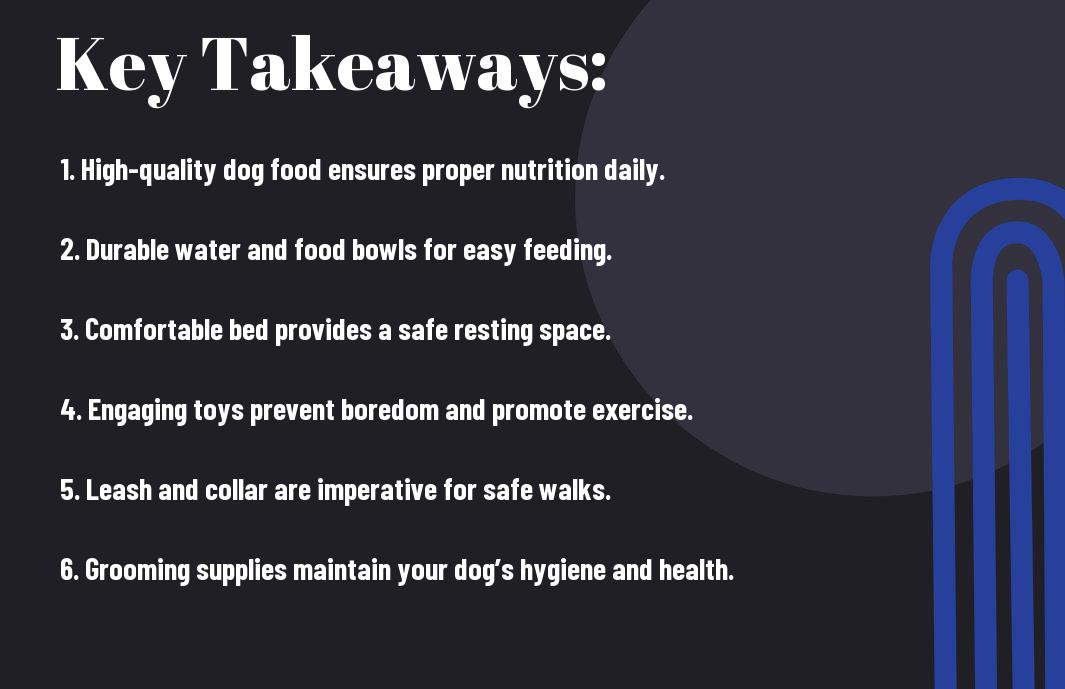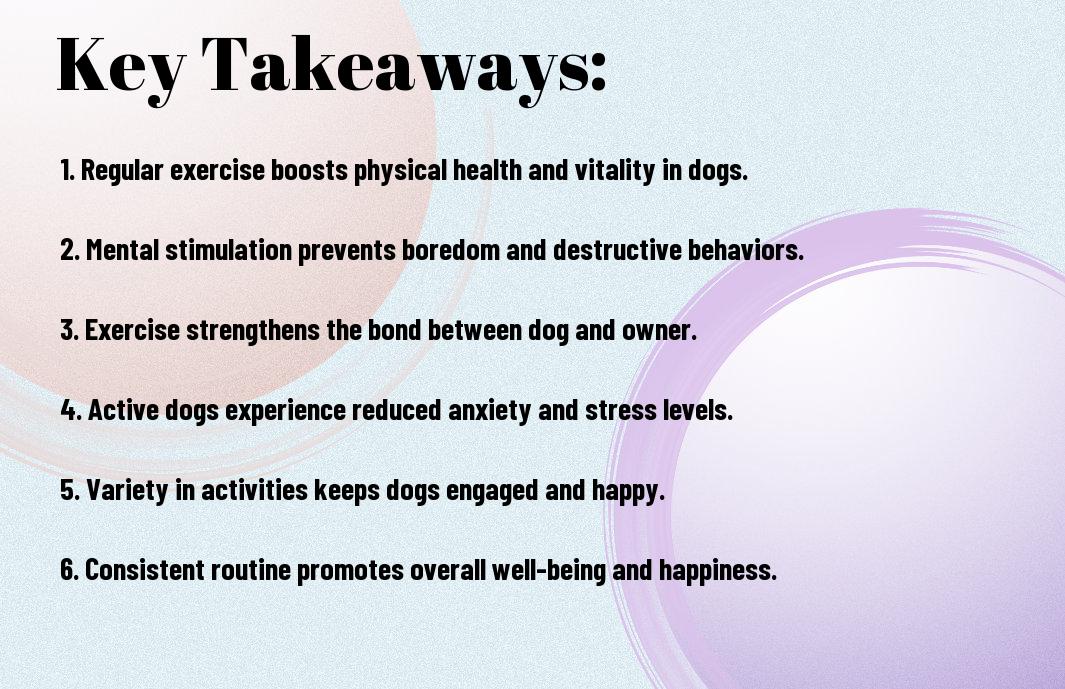Exercise is vital for maintaining your dog’s health and well-being. Regular physical activity helps prevent obesity, reduces behavioral problems, and strengthens their bond with you. Engaging in daily exercise not only keeps your dog physically fit but also promotes mental stimulation, enhancing their overall happiness. By prioritizing your furry friend’s exercise routine, you ensure they lead a longer, healthier life, free from common ailments linked to inactivity. Discovering the myriad benefits of regular exercise can transform both your and your dog’s daily life, leading to more joyful moments together.


Understanding Canine Exercise
While regular exercise is imperative for your dog’s overall well-being, understanding what constitutes exercise for dogs is equally important. You need to recognize that exercise goes beyond simple physical activity; it encompasses various activities that stimulate both your dog’s body and mind. This balanced approach to exercise ensures that your dog remains healthy, happy, and well-adjusted.
Definition of Exercise for Dogs
Above all, exercise for dogs can be defined as any activity that engages them physically and mentally. This includes walks, runs, play sessions, and interactive games that promote movement and cognitive stimulation. The primary objective is to keep your dog active and to prevent issues such as obesity and behavioral problems.
Additionally, exercising your dog also fosters a stronger bond between you and your pet. Engaging in activities that both of you enjoy can enhance your relationship and improve your dog’s social skills when interacting with other dogs and people.
Types of Exercise
When considering the types of exercise suitable for your dog, it’s imperative to understand the various activities that fall under this umbrella. You can engage your pet in different forms of exercise that cater to their energy level, age, and breed. Here’s a breakdown of some common types:
| Type | Description |
| Walking | Essential daily activity for dogs of all ages. |
| Running | Great for high-energy breeds that require more intense workouts. |
| Playtime | Interactive activities that promote fun and mental engagement. |
| Swimming | A low-impact exercise that’s great for dogs with joint issues. |
| Agility Training | Stimulating activity that boosts both physical and mental skills. |
Understanding the different types of exercise available allows you to tailor your approach based on your dog’s specific needs. Engaging in a variety of activities not only maintains their physical health but also enriches their mental state.
- Walking is fundamental for exercise.
- Running serves high-energy dogs well.
- Playtime enhances their mental state.
- Swimming offers a gentle approach.
- Agility Training sharpens their skills.
Perceiving your dog’s unique requirements and interests will help you create a well-rounded exercise routine that promotes a happy, healthy lifestyle. Regular exercise is imperative for maintaining their physical and mental health.
Physical Health Benefits
All dogs, regardless of their age or breed, can greatly benefit from regular exercise. Engaging in daily physical activity not only enhances their overall health but also promotes longevity and a happier lifestyle. As a responsible pet owner, incorporating exercise into your dog’s routine will help you both reap numerous benefits in both body and mind.
Weight Management
Between the abundance of tempting dog treats and the natural tendency to indulge in playtime lounging, it can be easy for your furry friend to pack on a few extra pounds. Regular exercise is important for maintaining a healthy weight for your dog, as it helps to burn off excess calories and builds lean muscle. This is particularly important because obesity can lead to a range of health issues, including diabetes, heart disease, and decreased quality of life.
By implementing a consistent exercise regimen, you can help your dog maintain an optimal weight. Aim for a mix of activities that include walking, running, and playing fetch—this variety will keep them engaged and motivated. Keeping your dog active will not only prevent weight gain but also increase their energy levels, allowing them to enjoy their daily activities more fully.
Cardiovascular Health
Cardiovascular health is vital to your dog’s overall well-being, as it affects their heart, lungs, and circulatory system. Regular exercise strengthens the heart muscle and improves circulation, promoting a healthy cardiovascular system. When you commit to a routine of physical activity with your canine companion, you are directly contributing to a longer, healthier life.
Moreover, regular exercise helps to regulate blood pressure and cholesterol levels, reducing the risk of heart disease. Engaging in aerobic activities, such as walking or jogging, elevates their heart rate, which is important for keeping their cardiovascular system in top shape. As you help your dog maintain their cardiovascular health, you are simultaneously fostering a strong bond through enjoyable experiences.
Joint and Muscle Strength
To ensure that your dog has strong muscles and healthy joints, regular physical activity is indispensable. Exercise helps to build and maintain muscle mass while promoting joint flexibility, which contributes to better mobility. This is especially important as dogs age, as they may become prone to joint problems like arthritis. Keeping your dog active will directly support their joint health, improving their overall quality of life.
Incorporating a variety of exercises, such as swimming, hiking, or agility training, can enhance both joint and muscle strength. These activities not only target different muscle groups but also minimize the risk of injury by providing a well-rounded fitness regimen. Investing time in your dog’s exercise routine now can prevent painful joint issues in the future.
Management of joint and muscle strength through regular exercise can make a significant difference in your dog’s mobility and comfort levels. Over time, you will likely notice your dog moving more fluidly and with greater confidence, which can enrich their enjoyment of life.
Enhanced Immune System
To optimally support your dog’s immune system, regular exercise plays a vital role. Just like in humans, consistent physical activity boosts the immune response, increases circulation, and helps to reduce inflammation. A well-exercised dog is less likely to fall ill, making it a smart strategy to prioritize regular exercise for your furry friend.
Additionally, the psychological benefits of exercise, such as reducing stress and anxiety, can also positively impact your dog’s immune system. Stress can weaken immunity, making your dog consistently vulnerable to infections and diseases. By providing your dog with daily exercise, you create a well-rounded approach to their health that extends to their immune function.
Plus, staying active leads to a healthier weight and better circulation, both of which are crucial for a well-functioning immune system. By observing these positive changes in your dog’s health, you can feel confident that you are taking the necessary steps to keep them happy, healthy, and thriving.
Behavioral Benefits
Unlike many people may think, regular exercise for your dog extends beyond physical health; it also significantly enhances their mental well-being and behavior. Engaging your dog in regular physical activity creates a happier, more balanced pet, transforming their overall temperament and reducing the likelihood of undesirable behaviors.
Reduction of Anxiety and Stress
Before you dismiss regular walks or playtime as just another part of your routine, consider the positive impact they can have on your dog’s emotional state. Dogs thrive on consistency and mental stimulation, and by providing them with a structured exercise routine, you can effectively lower their anxiety levels. Whether it’s a brisk walk in the park, a game of fetch, or even some light agility training, keeping your dog active helps them release pent-up energy that might otherwise manifest as stress or anxious behaviors.
Moreover, regular exercise helps to release endorphins, those feel-good hormones that promote an overall sense of well-being in your dog. This keeps them calm and focused, reducing the chances of disturbances at home, such as barking or pacing. Ultimately, a well-exercised dog is a happier, more relaxed companion.
Decrease in Destructive Behaviors
Across the board, you’ll find that dogs exhibiting destructive behaviors at home often do so due to lack of engagement and excess energy. When your dog doesn’t receive enough physical activity, they become bored, leading them to chew furniture, dig holes in the yard, or engage in other unwanted activities. By ensuring your dog has regular exercise, you’re effectively mitigating these destructive tendencies.
This isn’t just about managing their energy levels; it’s also about teaching your dog the right ways to channel their instincts. When your dog is physically active, they are less likely to resort to damaging behaviors as they have an appropriate outlet for their energy and natural instincts. Furthermore, incorporating structured play can also help to strengthen the bond between you and your dog, creating a more respectful and understanding relationship.
Improved Socialization Skills
An active dog has more opportunities to engage with other pets and people, which significantly improves their socialization skills. Regular outings to dog parks or even group classes provide crucial experiences that help your dog develop confidence and learn appropriate behavior when interacting with others. These interactions foster a sense of security for your dog and help to reduce fear-based reactions in social settings.
The benefits of improved socialization skills are vast; not only does it lead to a well-adjusted pet, but it also enhances your comfort level when you’re in public spaces. Your dog will be more adept at handling new situations, leading to fewer incidents of aggression or avoidance when faced with unfamiliar dogs or people. With a greater capacity for social interaction, your dog becomes a more enjoyable companion both at home and out in the community.
Mental Stimulation
To ensure your dog remains happy and healthy, it’s imperative to provide them with regular mental stimulation. Exercise not only benefits their physical health but also significantly contributes to their cognitive well-being. When your dog engages in activities that stimulate their mind, they can develop better problem-solving skills and enhance their overall behavior, leading to a more balanced and well-rounded companion. Regular exercise sessions can be an excellent opportunity for you to integrate fun activities that challenge your dog mentally while giving them the physical outlet they need.
Cognitive Benefits of Exercise
Mental stimulation through exercise promotes healthy brain activity and can even help to slow cognitive decline in older dogs. As your dog participates in various activities, they engage different areas of their brain. This can lead to improved memory and decision-making abilities, making your dog more responsive and easier to train. Additionally, dogs that receive regular cognitive challenges tend to exhibit fewer behavioral issues, as they are less likely to become bored or anxious.
Engaging Activities for Brain Health
On a similar note, incorporating engaging activities into your dog’s exercise routine not only benefits their physical health but also boosts their mental health. Activities like puzzle toys, obedience training, and agility courses can stimulate your dog’s mind and keep them alert and focused. These activities are particularly important for energetic breeds that thrive on both physical and mental challenges. By varying the types of mental exercises you offer, you can enrich your dog’s daily routine and create a more fulfilling experience for them.
Exercise that challenges your dog’s brain is vital for their overall well-being. Consider involving interactive games, such as hide and seek or treasure hunts, that allow your dog to utilize their senses and instincts. Games that reward your dog for solving puzzles or completing tasks foster a sense of accomplishment, leading to further cognitive development and a happy demeanor.
Importance of Variety in Activities
Activities that offer variety are imperative for keeping your dog engaged and active. Mixing up physical exercise routines with mental challenges can prevent your dog from falling into a monotonous pattern. As your dog becomes accustomed to specific activities, they may lose interest and engagement. Incorporating new experiences into their routine will keep their enthusiasm high and stimulate their minds, all of which help to maintain a joyful disposition.
Variety in activities not only combats boredom but also allows your dog to develop new skills and confidence. By introducing different types of challenges, you can help your dog discover their strengths and preferences, which leads to a more fulfilling exercise experience. This approach also fosters a strong bond between you and your furry friend, as you explore and learn together.

Age-Specific Exercise Recommendations
Puppies and Young Dogs
For puppies and young dogs, exercise is necessary for their physical and mental development. To promote healthy growth, you should aim for short, frequent play sessions throughout the day rather than long, strenuous activities. This helps prevent excess strain on their developing bones and joints. Generally, a good guideline is five minutes of exercise per month of age, with a maximum of 30 minutes for dogs up to six months old.
To engage your puppy effectively, incorporate activities that stimulate both their body and mind, such as gentle games of fetch or agility exercises tailored to their size. These activities not only help with their physical fitness but also enhance their socialization skills, making them well-rounded companions as they grow.
Adult Dogs
Young adult dogs typically require more structured exercise to maintain their health and energy levels. Young adult dogs generally benefit from at least 30 minutes to 2 hours of exercise each day, depending on their breed and individual fitness levels. You can tailor the type of exercise to your dog’s needs, whether it’s brisk walks, runs, or engaging in interactive play.
It’s necessary to monitor your adult dog’s behavior during and after exercise. If they show signs of lethargy or discomfort, you should adjust the intensity or duration of their activities. Make sure to include a combination of aerobic exercises and strength-building activities, such as hiking or swimming, to keep them engaged and fit.
It’s important to provide variety in your dog’s routine. Whether it’s introducing new trails for walks or incorporating toys that challenge them, maintaining an engaging exercise regime helps keep their mind active along with their body. Not only will this benefit their physical health, but it can also alleviate behavioral problems stemming from boredom.
Senior Dogs
Dogs in their senior years may require gentler exercise routines to accommodate their changing needs. You should focus on maintaining liver mobility and flexibility, opting for shorter walks supplemented by light activities. Depending on your dog’s health, aim for 20 to 60 minutes of exercise each day, adjusting as necessary to avoid overstretching their limits.
It’s important to watch for signs of fatigue or discomfort in your senior dog, adjusting their exercise accordingly. Incorporating low-impact activities, like swimming or gentle fetch, can greatly benefit their physical well-being while providing them with an opportunity for mental stimulation.
Indeed, recognizing that each dog’s needs may vary greatly according to health conditions or mobility issues is necessary. Providing your senior dog with consistent, low-impact exercise supports their overall well-being and can even help manage conditions like arthritis. Being proactive in adjusting their routine will ensure they remain happy and active in their golden years.
Safety Considerations
Now that you understand the benefits of regular exercise for dogs, it’s necessary to ensure their safety during these activities. Exercising your furry friend can lead to numerous positive outcomes, but being aware of certain safety considerations is just as important. By taking the necessary precautions, you can ensure that exercise remains a pleasurable experience for both you and your dog.
Understanding Your Dog’s Limits
Before you set out for a long run or an intense play session, it’s vital to assess your dog’s condition and capabilities. Each dog has its own unique fitness level, influenced by factors such as age, breed, size, and existing health conditions. If your dog is a senior or has any underlying health issues, consult your veterinarian prior to starting any new exercise regime. Always start slowly, especially if you are introducing a new type of exercise, and watch for signs of fatigue or discomfort.
Before increasing the intensity or duration of your dog’s exercise routine, be sure to evaluate their response to early sessions. Observe if they tire quickly or exhibit signs of reluctance. A well-rounded exercise plan should incorporate rest days to allow for recovery. Taking cues from your pet will help maintain their engagement and joy in exercising, leading to a happier, healthier companion.
Weather Conditions and Their Impact
Before planning your outdoor activities, consider the current weather conditions. Extreme temperatures, whether hot or cold, can pose significant risks to your dog’s health. Hot weather can lead to heat exhaustion or heat stroke, while cold weather can make your dog susceptible to hypothermia. Always check the temperature and humidity levels before heading outside, as some breeds are more sensitive to extreme weather than others.
Additionally, the surfaces your dog exercises on can impact their safety. During warmer months, asphalt can cause burns to their paws, while icy surfaces can lead to slips and falls. Choose the right time and environment to exercise, ensuring that your dog stays comfortable and safe.
In addition to these considerations, be aware of your dog’s behavior in different weather conditions. Some dogs may hesitate to exercise in the rain or snow, while others may revel in it. Adjust your plans accordingly, and on particularly hot days, aim for early morning or late evening walks when the temperatures are cooler.
Proper Hydration and Nutrition during Exercise
Safety should also include ensuring your dog is well-hydrated and adequately fueled for exercise. Just as you wouldn’t attempt a significant workout without proper hydration and nutrition, the same goes for your dog. Always have fresh water available before, during, and after exercise to prevent dehydration. Noticing signs of excessive panting or lethargy can be indicators that your dog needs to take a break and rehydrate.
Furthermore, keep in mind that a balanced diet is necessary in supporting your dog’s activity level. Depending on the length and intensity of their workouts, you may need to adjust their meals accordingly. Pay attention to any changes in their eating habits, and consider consulting a vet for personalized nutritional advice tailored to your dog’s exercise needs.
Impact of proper hydration and nutrition cannot be overstated. Providing your dog with the right nutrients before exercise ensures they have the energy needed to engage and enjoy their activities fully. Moreover, regular access to water and a nutritious diet helps maintain optimal performance and reduces the risk of health issues, allowing your dog to thrive.
To Wrap Up
Now that you are aware of the benefits of regular exercise for your dog, you can make informed choices about their physical activity. Consistent exercise not only keeps your dog physically fit but also contributes significantly to their mental health. Engaging in various activities, from simple walks to interactive play sessions, helps alleviate behavioral issues and enhances their overall quality of life. By incorporating a regular exercise routine, you can ensure that your furry friend leads a happy and healthy life.
Ultimately, your commitment to providing consistent exercise will foster a stronger bond between you and your dog. The joy you both experience during playtime transforms mundane routines into treasured moments. By prioritizing your dog’s exercise needs, you contribute to their longevity and well-being, allowing them to thrive alongside you for many joyful years to come. Make regular exercise a vital part of your dog’s daily routine, and watch them flourish both physically and emotionally.
Q: What are the physical benefits of regular exercise for dogs?
A: Regular exercise significantly contributes to a dog’s overall health. It helps maintain a healthy weight, reducing the risk of obesity-related illnesses. Increased physical activity promotes cardiovascular health and strengthens muscles and bones. Moreover, exercise enhances flexibility and coordination, which can help prevent injuries, especially as dogs age. Overall, an active lifestyle boosts a dog’s vitality and longevity.
Q: How does exercise impact a dog’s mental well-being?
A: Engaging in regular exercise not only stimulates a dog’s body but also their mind. Physical activities can reduce anxiety and stress levels, as they provide an outlet for pent-up energy. Mental stimulation from varied exercises, like agility training or fetch, helps prevent behavioral issues stemming from boredom. Additionally, regular exercise fosters a stronger bond between the dog and its owner, enhancing social interaction and providing psychological enrichment.
Q: What types of exercises are suitable for different breeds and ages of dogs?
A: The type and intensity of exercise suitable for a dog depend on its breed, age, and health condition. High-energy breeds, such as Border Collies or Retrievers, thrive with rigorous activities like running or playing fetch. In contrast, brachycephalic breeds may require shorter, less intense sessions to accommodate their breathing limitations. Puppies may benefit from short bursts of play, while senior dogs often prefer gentle walks or light activity. It’s important to tailor the exercise routine to fit the individual dog’s needs and capabilities for optimal benefits.










